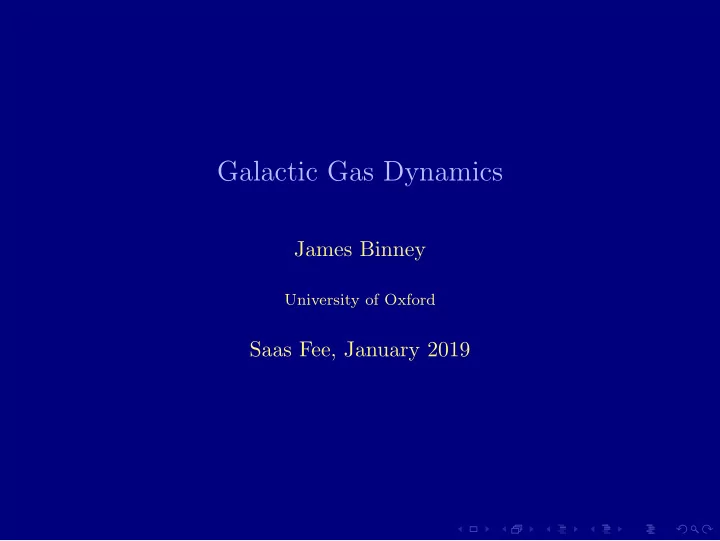

Galactic Gas Dynamics James Binney University of Oxford Saas Fee, January 2019
Basics ◮ Surveys of 21 cm H hyperfine line gave 1st global view of MW (Oort, Kerr & Westerhout 1958) ◮ Followed in 1970s by similar surveys at small ℓ in 2.6 mm line of CO ◮ Surveys yield ( ℓ, v ) plots: ◮ not easy to interpret ◮ but contain much diagnostic information ◮ Major task now with Gaia data: ◮ to bring together gas & star distributions & kinematics
Circular hypothesis ◮ Traditionally assume circular motion ◮ Then v � ( ℓ ) = [Ω( R ) − Ω( R 0 )] R 0 sin ℓ ◮ ‘Terminal v’ the peak at R = R 0 sin ℓ → V c ( R 0 sin ℓ ) ◮ At | ℓ | < 90 ◦ same v � at 2 locations of same R ◮ → ambiguity in ‘kinematic distance’
Terminal velocities Even now Φ( R ) usually constrained within circular hypothesis
HI plot ◮ Observed ( ℓ, v ) planes show strings and ridges ◮ Spiral arms?
Spirals → ridges
CO plot ◮ CO ( ℓ, v ) plane shows ◮ Molecular ring ◮ Nuclear parallelogram ◮ Both CO and HI planes show material at ‘forbidden velocities’
Evidence for a bar ◮ Binney+ (1991) argued parallelogram is a diagnostic of a rotating bar ◮ hypothesised that gas spirals in along closed x 1 orbits ◮ until it reaches cusped orbit ◮ The shock then transfers it to (closed) x 2 orbits
Hydro simulations ◮ Sormani+ (2015a) tested hypothesis with hydro simulations ◮ Resolution and c s prove important
Hydro simulations Gas reaches cusped orbit only at high c s and resolution
New interpretation of CO parallelogram
Bar-driven spirals (Sormani+ 2015b) Bar drives spirals in gas
Bar-driven spirals (Sormani+ 2015b) ◮ Spirals reflect twisted streamlines
Dynamical model (Sormani+ 2015b) ◮ Can be modelled as driven, damped epicycles (Wada 1994) ◮ Major exes of closed orbits swing through 90 ◦ at LR x + κ 2 x = f ( t ) ¨ x + κ 2 x = f ( t ) → ¨ x + λ ˙
Strong & weak bars • If bar weak, epicycles can be around circular orbit • In strong bar must be libration around eccentric closed orbit
Fitting observations (Sormani+ 2015c) ◮ Assume Φ( R, φ ) = Φ( R ) + Φ 2 ( R ) cos(2 φ )
Models for Ω p = 40
Models for Ω p = 60
Constraints on Φ ◮ Extent of emission at v forbidden increases as Ω p drops ◮ Suggests Ω p = 30 − 40 km s − 1 / kpc ◮ 3 kpc arm needs long bar r q > 1 . 5 kpc & strong quadrupole ◮ Argues against high Ω p ◮ Molecular ring also favours Ω p ∼ 40 ◮ Envelope at ℓ > 0 and permitted v favours Ω p = 50 − 60 but at ℓ < 0 envelope favours Ω p = 40 ◮ Bumps on envelope: sensitive to quadrupole ◮ Too many parameters for a thorough model search
Asymmetry of CMZ CO NH 3 3 4 of molecular emission from ℓ > 0 ◮ ◮ Long-standing puzzle
Wiggle instability ◮ At high c s & resolution flow becomes unsteady ◮ Unsteadiness is code-independent except suppressed by highly diffusive flux limiter (thick shocks) ◮ Vorticity arises in shocks (high shear) & moves into flow ◮ Vortices amplified in opposite shock ◮ Phenomenon discovered by Kim+ (2012) ◮ Shocks with periodic bdy conds are unstable (Sormani+ 2017)
Sormani+ 2018 ◮ High resolution 3d simulations of gas flow in fixed bar (AREPO) ◮ Complex chemical network included ◮ Switch-on of bar → gas ∼ on x 1 & x 2 orbits
Unsteady flow with phase changes (Sormani+ 2018) HI much smoother than CO
Sormani+ 2018 CO in a handful of stringy clouds → strong asymmetry
Phenomenology of the CMZ ◮ Intense SF in R ∼ 200 pc x 2 disc ◮ 90 cm radio-continuum map ◮ ‘hour-glass’ plume of soft X-ray emission (Bland-Hawthorn & Cohen 2003)
CMZ ◮ Fermi bubble ◮ Stellar cpt discovered in APOGEE data (Sch¨ onrich+ 2015)
Recommend
More recommend